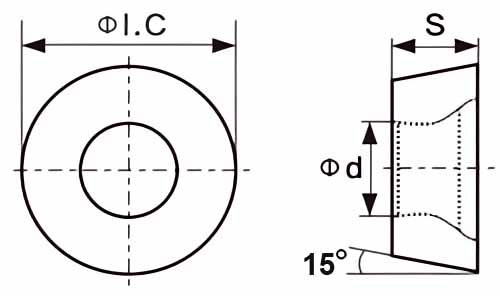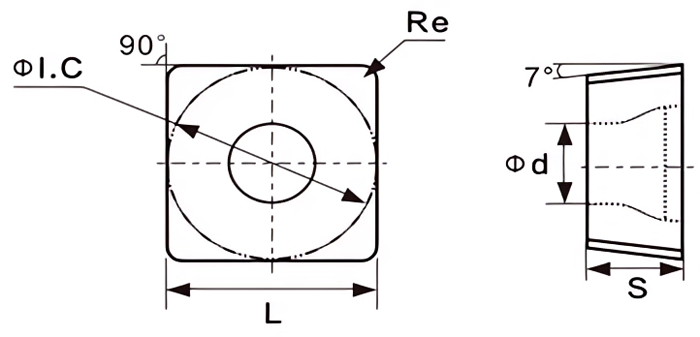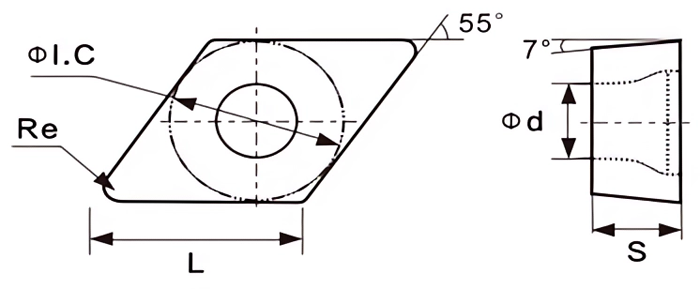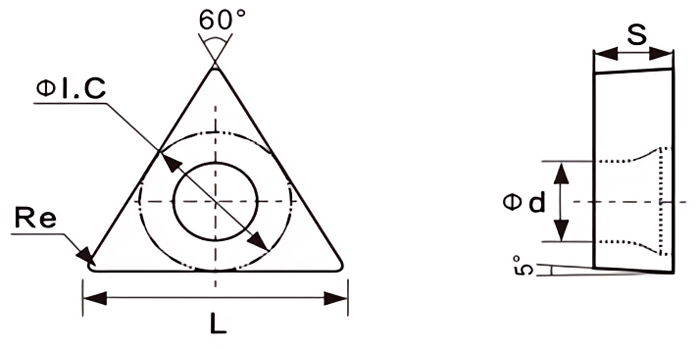Introduction : L'épine dorsale des opérations de tournage efficaces
Dans le monde de l'usinage, tournage général inserts sont les bêtes de somme qui façonnent et affinent les pièces cylindriques, favorisant l'efficacité et la précision dans tous les secteurs d'activité. Ces outils de coupe polyvalents, généralement fabriqués en carbure de tungstène, sont essentiels pour une large gamme d'opérations de tournage, de l'ébauche à la finition. Ce guide complet se penche sur le domaine des plaquettes de tournage générales, en explorant leurs types, leurs applications, leurs critères de sélection et les éléments clés à prendre en compte pour obtenir des performances d'usinage optimales.
Comprendre les plaquettes de tournage général : Qu'est-ce que c'est ?
Définition de l'outil de coupe :
A plaquette de tournage général est un outil de coupe de précision conçu pour être utilisé dans les opérations de tournage, généralement dans un porte-outil monté sur un tour. Ces plaquettes comportent plusieurs arêtes de coupe, ce qui permet d'indexer une nouvelle arête en cas de besoin, de maximiser la durée de vie de l'outil et de minimiser les temps d'arrêt. Elles sont spécialement conçues pour enlever de la matière du diamètre extérieur des pièces tournantes, créant des formes cylindriques, des épaulements, des rainures et d'autres caractéristiques.
Principaux avantages des plaquettes de tournage générales :
- Dureté et résistance à l'usure exceptionnelles : Généralement fabriquées en carbure de tungstène, un matériau composite réputé pour sa dureté, les plaquettes de tournage général peuvent résister aux températures et aux forces élevées générées pendant l'usinage, ce qui garantit une durée de vie prolongée de l'outil et des performances constantes.
- Conception indexable pour une utilisation maximale de l'outil : Les multiples arêtes de coupe sur une seule plaquette permettent l'indexation, ce qui maximise l'utilisation de la plaquette avant qu'il ne soit nécessaire de la remplacer. Cette conception permet de réduire les coûts d'outillage et de minimiser les temps d'arrêt liés aux changements d'outils.
- Polyvalence dans les opérations de tournage : Les plaquettes de tournage général sont disponibles dans une large gamme de géométries, de nuances et de revêtements, ce qui les rend adaptées à une variété d'opérations de tournage, y compris l'ébauche, la semi-finition et la finition, dans une large gamme de matériaux.
- Rapport coût-efficacité et efficience : La combinaison de la durée de vie prolongée de l'outil, de la polyvalence et des vitesses de coupe élevées offertes par les plaquettes de tournage général contribue à accroître l'efficacité de l'usinage et à réduire les coûts de fabrication globaux.
Approfondir : Types, géométries et niveaux
Un monde de choix :
Les plaquettes de tournage général sont disponibles dans une variété de types, chacun optimisé pour des matériaux et des opérations d'usinage spécifiques. Les types les plus courants sont les suivants :
- Inserts revêtus CVD : Dotés d'un revêtement fin et dur appliqué par dépôt chimique en phase vapeur (CVD), ces inserts offrent une excellente résistance à l'usure, ce qui les rend adaptés à l'usinage à grande vitesse et aux applications exigeantes.
- Inserts revêtus de PVD : Grâce au dépôt physique en phase vapeur (PVD), ces plaquettes présentent un revêtement plus fin et plus conforme, souvent à des températures de coupe plus basses, ce qui les rend adaptées aux applications nécessitant des arêtes plus vives et des finitions de surface améliorées.
- Inserts en cermet : Composées d'un composite céramique-métal, ces plaquettes offrent une dureté et une résistance à l'usure élevées, en particulier à des températures élevées, ce qui les rend adaptées à l'usinage d'aciers trempés et d'autres matériaux difficiles à découper.
- Plaquettes CBN : Les plaquettes en nitrure de bore cubique (CBN) sont exceptionnellement dures et résistantes à l'usure, après le diamant, ce qui les rend idéales pour l'usinage des aciers trempés, de la fonte et d'autres matériaux abrasifs.
Décoder les géométries des plaquettes : Façonner la coupe
Les géométries des plaquettes, y compris les angles de coupe, les angles de dépouille et les brise-copeaux, jouent un rôle crucial dans la formation et l'évacuation des copeaux, ainsi que dans l'état de surface.
- Angle d'inclinaison : L'angle entre la face de coupe de la plaquette et une ligne perpendiculaire à la surface de la pièce. Les angles de coupe positifs réduisent les efforts de coupe et génèrent des copeaux plus fins, tandis que les angles de coupe négatifs augmentent la résistance des arêtes et améliorent le contrôle des copeaux.
- Angle de dégagement : L'angle entre la face de dégagement de la plaquette et la tangente à la surface de la pièce au niveau du point de coupe. Un angle de dépouille suffisant empêche le frottement entre la plaquette et la pièce, réduisant ainsi la production de chaleur et l'usure de l'outil.
- Casse-pipe : Une rainure ou une indentation sur la face de coupe de la plaquette qui contrôle la formation de copeaux et dirige le flux de copeaux loin de la zone de coupe, empêchant l'accumulation de copeaux et améliorant la finition de la surface. Différents styles de brise-copeaux sont disponibles en fonction des matériaux et des exigences de contrôle des copeaux.
Formes générales courantes des plaquettes de tournage :
Les plaquettes de tournage général se présentent sous diverses formes, chacune étant conçue pour des opérations de coupe et des géométries de pièces spécifiques. Voici quelques-unes des formes les plus courantes :
- Inserts ronds (forme S) : Offrant une arête de coupe solide et une bonne évacuation des copeaux, les plaquettes rondes sont polyvalentes et adaptées aux opérations de coupe en continu, en particulier pour les surfaces courbes et le profilage.
- Inserts carrés (forme S) : Offrant une arête de coupe droite et une bonne finition de surface, les plaquettes carrées sont couramment utilisées pour les opérations de surfaçage, d'épaulement et de tournage nécessitant une grande précision.
- Inserts triangulaires (forme en T) : Dotées de trois arêtes de coupe, les plaquettes triangulaires offrent une bonne évacuation des copeaux et sont couramment utilisées pour les travaux de tournage moyens à lourds, en particulier pour les coupes interrompues et les opérations d'ébauche.
- Inserts diamantés (forme D) : Grâce à leurs arêtes de coupe tranchantes et à leur capacité à supporter des vitesses d'avance élevées, les plaquettes diamantées sont souvent utilisées pour les opérations de finition, permettant d'obtenir d'excellents états de surface sur divers matériaux.
- Inserts rectangulaires (forme R) : Offrant une arête de coupe longue et droite, les plaquettes rectangulaires conviennent aux opérations de tournage, de rainurage profond et de tronçonnage les plus exigeantes.




Comprendre les nuances de carbure : Le système de classification ISO
Les nuances de carbure, classées selon le système de l'Organisation internationale de normalisation (ISO), indiquent les propriétés et les applications spécifiques des plaquettes en carbure de tungstène. La classification ISO se compose d'une lettre (groupe d'application) et d'un chiffre (dureté et ténacité).
- Groupes d'application :
- P : Pour l'usinage de l'acier, des pièces moulées en acier et des matériaux à copeaux longs.
- M : Pour l'usinage des aciers inoxydables, des alliages à haute température et d'autres matériaux difficiles à couper.
- K : Pour l'usinage de la fonte, des métaux non ferreux et des matériaux non métalliques.
- Dureté et résistance : Le chiffre qui suit la lettre indique la résistance à la rupture transversale (TRS) en N/mm² et la dureté (HV). Les chiffres les plus élevés indiquent généralement une dureté et une résistance à l'usure plus élevées, mais une ténacité plus faible.
Applications dans toutes les industries : Quand la précision rencontre la performance
Favoriser l'efficacité dans les secteurs clés :
Les plaquettes de tournage général sont des outils indispensables dans un grand nombre d'industries, notamment
- Automobile : Fabrication de composants de moteurs, de pièces de transmission, d'essieux et d'autres composants critiques exigeant une grande précision et une grande durabilité.
- Aérospatiale : Production de composants de trains d'atterrissage, de pièces de moteurs, d'éléments structurels et d'autres pièces exigeant une résistance et une fiabilité exceptionnelles.
- Fabrication de dispositifs médicaux : Création d'implants, d'instruments chirurgicaux et d'autres dispositifs médicaux nécessitant des tolérances étroites et une biocompatibilité.
- L'énergie : Usinage de composants pour l'exploration pétrolière et gazière, la production d'électricité et les systèmes d'énergie renouvelable, souvent dans des conditions extrêmes.
- Fabrication générale : Largement utilisé dans les ateliers d'usinage, les installations de fabrication et les usines de production pour une variété d'opérations de tournage sur une large gamme de matériaux.
Comparaison des fournisseurs : Naviguer sur le marché des plaquettes de tournage général
| Fournisseur | Localisation | Fourchette de prix (par encart) | Spécialités |
|---|---|---|---|
| Sandvik Coromant | Suède | $8 – $50+ | Large gamme d'inserts pour diverses applications, revêtements avancés et géométries, reconnus pour leur innovation et leur haute performance. |
| Kennametal | ÉTATS-UNIS | $7 – $45+ | Des plaquettes de haute performance pour des applications exigeantes, des solutions d'outillage innovantes et une attention particulière portée aux solutions spécifiques des clients. |
| TRUER | Chine | $6 – $40+ | Diverses géométries d'inserts, des solutions rentables et un fort accent sur la recherche et le développement, connu pour sa série LOGIQ. |
| Outils Walter | Allemagne | $9 – $55+ | Gamme complète de plaquettes, de systèmes d'outillage et de fluides de coupe, axée sur la précision, la performance et les solutions numériques. |
Peser le pour et le contre : avantages et limites
| Avantages | Limites |
|---|---|
| Dureté et résistance à l'usure exceptionnelles | Coût initial plus élevé que celui des outils en acier rapide, mais compensé par une durée de vie plus longue. |
| Conception indexable pour une utilisation maximale de l'outil | Nécessite un système de porte-outils spécifique et un serrage adéquat |
| Large gamme de qualités, de géométries et de revêtements pour répondre à diverses applications | Une sélection et une application correctes sont cruciales pour une performance et une durée de vie optimales de l'outil. |
| Vitesses de coupe et vitesses d'avance élevées pour une productivité accrue | Peut être fragile et susceptible de s'écailler sous l'effet de chocs ou d'une utilisation inadéquate. |
La différence TRUER : Pourquoi nous choisir pour vos besoins en plaquettes de tournage général ?
Partenariat avec un leader de la technologie de pointe :
- Une qualité sans compromis : Nous nous approvisionnons en plaquettes de tournage général auprès de fabricants réputés, ce qui garantit une qualité, des performances et une fiabilité constantes pour vos opérations d'usinage les plus exigeantes.
- Expertise spécifique à l'application : Notre équipe d'ingénieurs expérimentés peut vous aider à sélectionner les plaquettes optimales pour vos besoins de tournage spécifiques, en tenant compte des matériaux, des opérations, des résultats souhaités et de la rentabilité.
- Prix compétitifs et livraison dans les délais : Nous proposons des prix compétitifs et nous nous efforçons de livrer les commandes rapidement, en minimisant les temps d'arrêt et en maximisant votre productivité. Notre objectif est d'être votre partenaire de confiance pour atteindre l'excellence en matière d'usinage.
Vous souhaitez acheter une plaquette en carbure de grande qualité au meilleur prix ? Cliquez ici ici.
Foire aux questions : Répondre à vos questions générales sur l'insertion de tournures
1. Comment choisir la bonne nuance de carbure pour mon application de tournage ?
Tenez compte du matériau usiné (dureté, usinabilité), du type d'opération de tournage (ébauche, finition), de la durée de vie souhaitée de l'outil et des paramètres de coupe (vitesse, avance, profondeur de coupe). Consultez les catalogues des fournisseurs, les ressources en ligne ou demandez l'avis d'un expert pour déterminer la nuance la plus appropriée.
2. Quels sont les facteurs qui influencent le choix de la géométrie des plaquettes pour le tournage ?
Les facteurs à prendre en compte sont la matière à usiner, la profondeur de coupe, l'état de surface souhaité, les capacités de la machine-outil (puissance, rigidité) et les exigences en matière de contrôle des copeaux. Chaque géométrie présente des avantages et des inconvénients, c'est pourquoi il est essentiel de l'étudier attentivement.
3. Comment savoir quand indexer ou remplacer une plaquette de tournage général ?
Les signes d'usure comprennent l'augmentation des efforts de coupe, un mauvais état de surface, un échauffement excessif et l'écaillage ou la rupture de l'arête de coupe. L'inspection régulière de la plaquette est essentielle pour éviter une défaillance catastrophique de l'outil et garantir une qualité d'usinage constante.
4. Quels sont les avantages de l'utilisation de plaquettes de tournage générales revêtues ?
Les revêtements, tels que le nitrure de titane (TiN), le carbonitrure de titane (TiCN) et l'oxyde d'aluminium (Al2O3), améliorent la durée de vie de l'outil, sa dureté, sa résistance à l'usure, sa résistance à l'oxydation et son pouvoir lubrifiant. Ils permettent des vitesses de coupe plus élevées, des vitesses d'avance plus importantes et une meilleure évacuation des copeaux, ce qui stimule la productivité.
5. Comment entretenir et stocker correctement les plaquettes de tournage général ?
Stocker les plaquettes dans un environnement propre et sec, à l'abri des chocs, de l'humidité et des températures extrêmes. Utilisez des brosses à copeaux et des méthodes de nettoyage appropriées pour éliminer les copeaux et les débris après chaque utilisation. Un stockage et un entretien corrects peuvent considérablement prolonger la durée de vie de vos plaquettes et garantir des performances constantes.




